Crosses

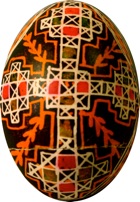
The crosses found on traditional pysanky were generally large, covering one whole side of a pysanka, and equilateral, with all four arms of equal length. In “Ukrainian Arts,” Yara Surmach gives three examples of this type of cross; she describes them as “the Greek cross with four equal arms, either straight with a small cross on each arm, or in the form of triangles turned with their points to the center and the base broken by a wedge. Sometimes the arms become a rhomb, thus forming the ancient Byzantine cross.”

She also goes on to describe crosses with a “Latin” (aka Catholic) influence, those with a prolonged lower arm, and gives the examples below. While both are truly christian crosses, the one on the right is known as the Suppedaneum cross, and is an orthodox cross:


While both these crosses can be seen on pysanky, they are relatively rare, and seen more often on modern folk pysanky than on older ones. Another “Latin” influence, according to Surmach, is the St. Andrew’s cross, an oblique cross with the arms treated as triangles:

While oblique crosses are not uncommon on pysanky, they probably take their roots not from St. Andrew, but from Svaroh, the ancient Slavic god of the sky (from the Sanskrit swarga ‘sky’), the sun, and heavenly fire (thunder). The svarha (swastika), was a tilted cross, and represented the motion of the sun through the sky.

As Vira Manko notes, crosses of the “agricultural” sort were widely divided; the arms might be opened or closed, but they divided space into four:

The cross on the right, above, is an example of a cross with a superimposed svarha.
А variation on the “open” crosses is the diamond cross; it is an upright cross formed from five diamonds. The diamonds are usually filed with decorative elements; these are not infrequently found on Bukovynian pysanky:

On Bukovynian pysanky of the Hutsul type, you will often see a cross crosslet–a cross with each arm crossed, a variation of the Greek cross, as mentioned above:
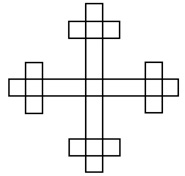
Sometimes this type of cross is fairly straightforward, as in the line drawing shown. At other times they may be much more complex, and instead contain lots of piled up squares, some with Xs through them. Small versions, like the cross below, are often seen:

The classic compound cross, however, is a much larger version, will have four or five such components, arranged like the small bars on the cross crosslet. You can see an example in the photo below:

The cross is often combined with the ruzha (another star symbol) to create a complex hybrid symbol. Sometimes the ruzha is simply the central motif of the cross; other times small ruzhy are arranged on the arms as the bars are on a cross crosslet:
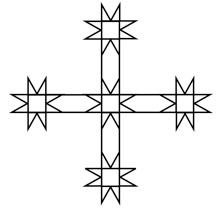
The cross is an ancient symbol, a simple geometric form whose meaning has changed much over time. Early crosses had arms of equal length. In ancient agricultural times, the cross symbolized the god of the earth. It was also a sun symbol, with the svarha, or broken cross, depicting the movement of the sun through the sky
The “sloping” cross, X, was a goddess symbol.


Often the two crosses were combined, symbolizing the notion of the male and female union as the driving force of life.




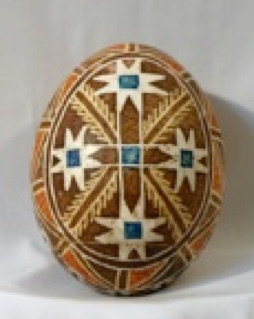
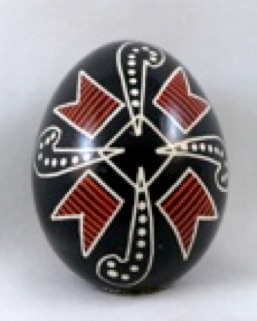


In more recent times, the cross has come to take on a Christian meaning. While the ancient equilateral crosses are still most commonly seen on pysanky, the Christian cross, with its unequal arms, can sometimes be seen on more modern Hutsul pysanky.


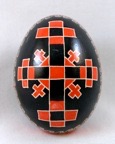
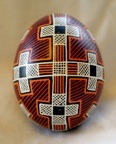
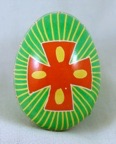
Christian adapted symbols are fairly common. The cross, which in pagan times represented the four sides of the earth, or the four element (earth, wind, water, fire), now depicts the Christ and christianity.

The cross is a fairly commonly design element in pysanky, whether subtly incorporated into a band, or as the most prominent motif.
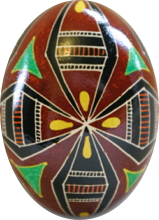

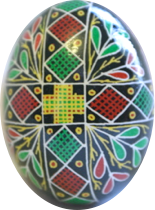
Simple crosses, with two equal arms, are seen most commonly.
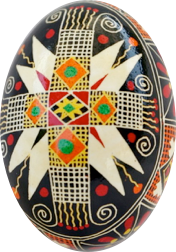
The Ukrainian Orthodox cross is sometimes shown, either with three bars (as below), or with the two lower bars. This cross is used by both Ukrainian Orthodox and Greek Catholic (Byzantine rite) worshippers in Ukraine. (The Russian Orthodox cross has a much longer upper bar.)
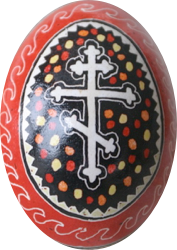
Hutsul folk pysanky sometimes depict simple Christian crosses. These are obviously newer pysanka dеsigns with christian motifs:
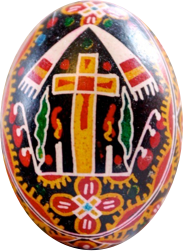

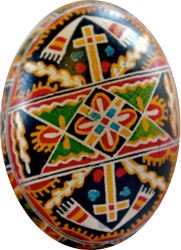
Crosses UNDER CONSTRUCTION



